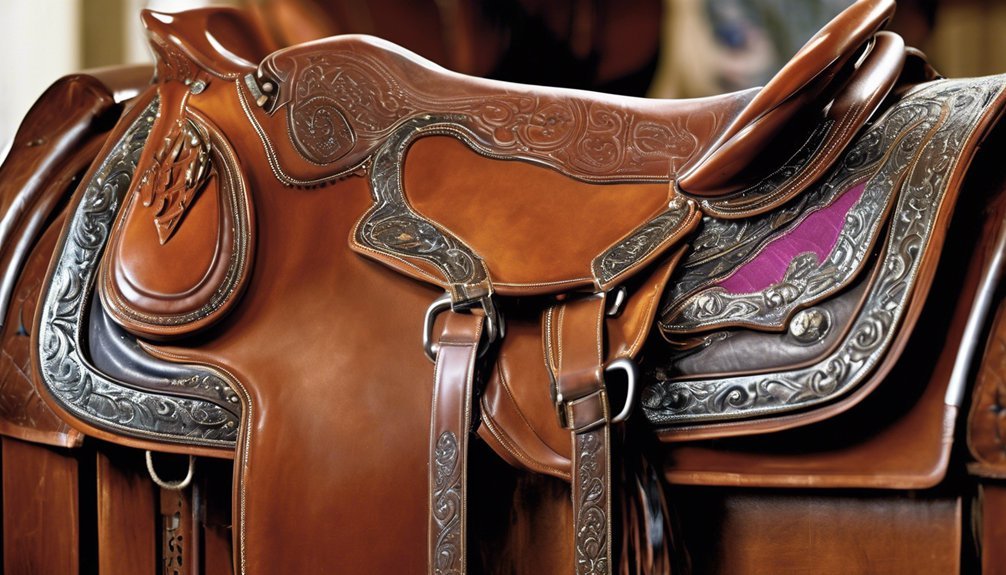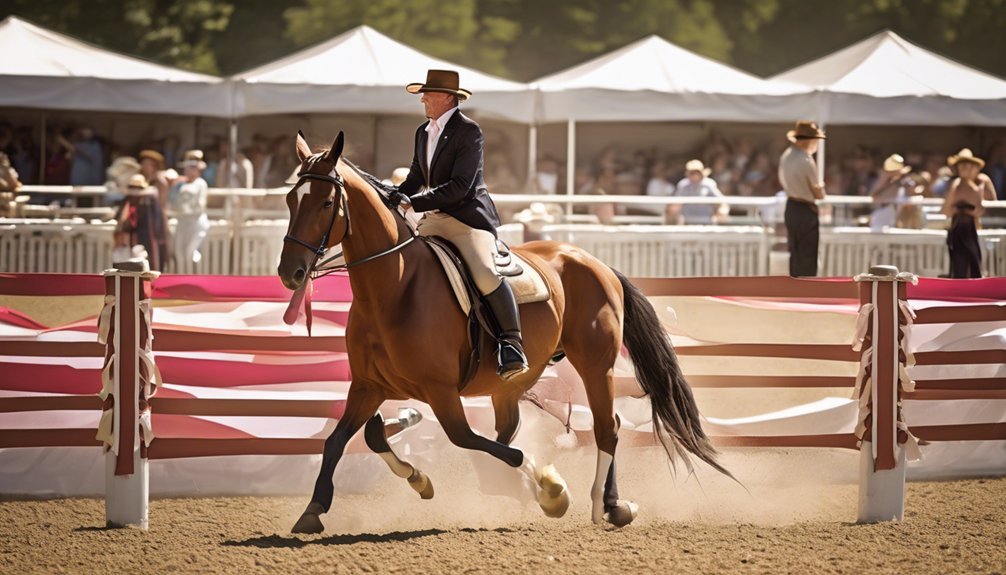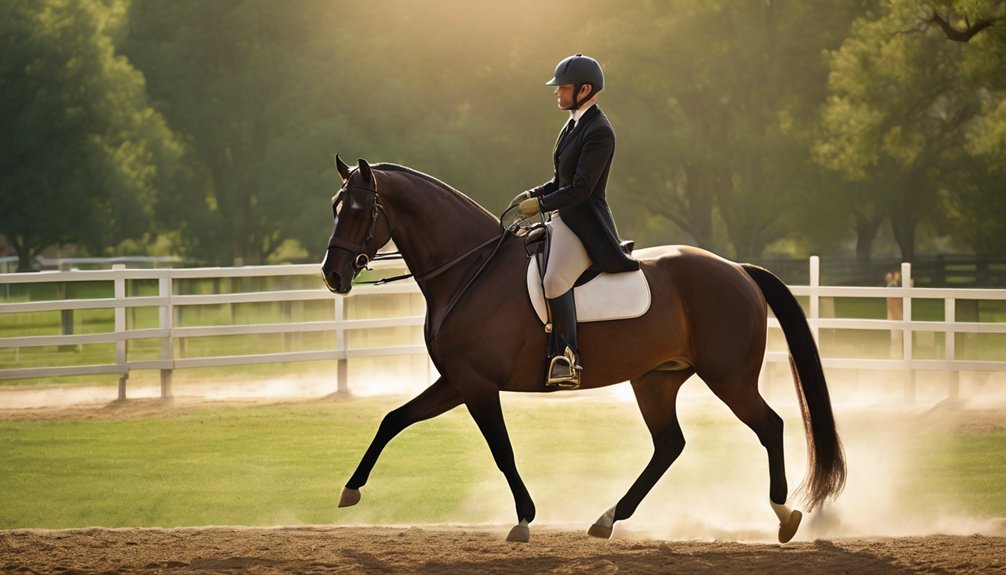
Conditioning a gaited horse for competition isn't just about getting them fit; it's an art form that requires precision and dedication. To truly excel, you need to understand their unique needs and create a tailored training regimen. From establishing a balanced schedule to enhancing core strength and flexibility, every detail matters. So, how do you ensure your horse is not only fit but also mentally prepared for competition day? Let's explore the best strategies to achieve this.
Key Takeaways
- Incorporate 3-5 training sessions per week, balancing aerobic work, speed training, and rest days for optimal conditioning.
- Focus on core strengthening with ground poles and transitions to improve balance, flexibility, and endurance.
- Provide a tailored nutrition plan with high-quality forage and grains, supplementing for stamina and recovery as needed.
- Maintain clean, well-fitted tack and equipment, organizing essentials for easy access during competitions.
- Utilize visualization techniques to enhance performance confidence and prepare for various competition scenarios.
Understanding Gaited Horses and Their Unique Needs
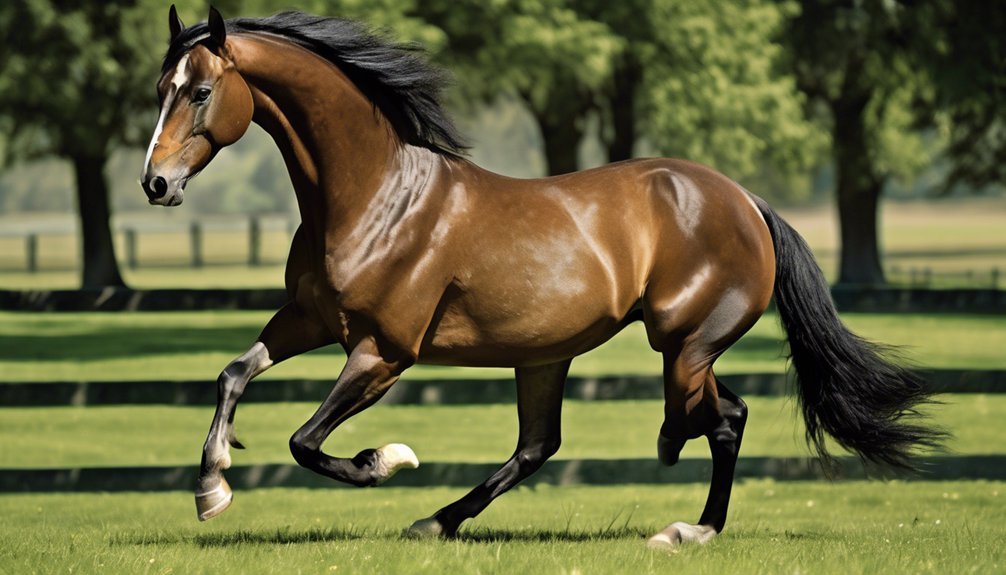
When you're working with gaited horses, it's essential to recognize their unique needs, as these horses possess distinct gaits that set them apart from their non-gaited counterparts.
Understanding gaited horse characteristics, like their smooth, rhythmic movements, helps you to connect with them effectively. These horses often exhibit unique movement patterns, such as the rack or the tölt, requiring specialized training techniques.
You'll want to focus on maintaining their natural stride while building strength and flexibility. Pay attention to their build and temperament, as each gaited horse is an individual.
By recognizing these traits, you'll foster a deeper bond and enhance your horse's performance, ensuring they thrive in competition settings.
Establishing a Conditioning Schedule
A well-structured conditioning schedule is crucial for preparing your gaited horse for competition. To optimize your horse's performance, establish a routine that emphasizes conditioning frequency and training consistency. Aim for 3-5 sessions per week, mixing aerobic work, speed, and hill training. Here's a simple schedule to guide you:
| Day | Activity | Duration |
|---|---|---|
| Monday | Aerobic Work | 30 minutes |
| Wednesday | Speed Training | 20 minutes |
| Friday | Hill Work | 25 minutes |
| Saturday | Light Trail Ride | 1 hour |
| Sunday | Rest | – |
Adjust the intensity as your horse builds strength. Regular assessments will help you fine-tune the schedule, ensuring your horse feels energized and ready for competition.
Strengthening Core Muscles for Improved Gait
Strengthening your gaited horse's core muscles is essential for achieving a more balanced and efficient gait. Focus on exercises that promote core stability, as this enhances muscle engagement throughout the body.
Incorporate ground poles or cavaletti to encourage your horse to lift its back and engage its abdominal muscles. Additionally, transitions between different gaits can help activate the core, providing both strength and flexibility.
Incorporating lateral work, like leg yields, challenges your horse's balance and coordination while further developing those vital core muscles.
Remember, a strong core not only improves performance but also supports your horse's overall health and longevity in competition.
With consistent practice, you'll see remarkable improvements in your horse's gait and overall athleticism.
Incorporating Slow and Fast Work

Incorporating both slow and fast work into your training regimen is crucial for developing your gaited horse's overall performance and stamina. Slow work helps build endurance and encourages relaxation, while fast work enhances speed and agility. Balancing these two elements will lead to a more versatile and responsive horse.
| Type of Work | Benefits | Suggested Duration |
|---|---|---|
| Slow Work | Builds endurance, enhances relaxation | 30-45 minutes |
| Fast Work | Improves speed, increases agility | 15-20 minutes |
| Combination | Develops versatility, boosts confidence | Varies based on horse's fitness level |
| Rest Days | Aids recovery, prevents burnout | 1-2 days per week |
Incorporate both types of work to achieve a well-rounded, competitive gaited horse.
Utilizing Groundwork for Flexibility
While you might focus on riding exercises, utilizing groundwork for flexibility is equally important in conditioning your gaited horse. Groundwork exercises can enhance your horse's range of motion, helping to prevent injuries and improve overall performance.
Start with simple flexibility drills, like lateral movements, to encourage your horse to stretch and engage different muscle groups. Incorporate bending and yielding exercises to promote suppleness in your horse's body.
As you work together, pay attention to your horse's responses—this builds trust and strengthens your bond. Consistent groundwork not only prepares your horse physically but also mentally, creating a more responsive partner.
Focusing on Nutrition for Optimal Performance
To achieve optimal performance in your gaited horse, you must prioritize nutrition as a vital component of their conditioning program.
Start by establishing consistent feeding schedules to ensure your horse receives balanced meals at the same times each day. This stability promotes digestive health and energy levels.
Incorporate high-quality forage and grains tailored to your horse's needs, adjusting portions based on their activity level.
Don't overlook nutritional supplements; they can fill dietary gaps and enhance stamina, muscle recovery, and joint health.
Consult with a veterinarian or equine nutritionist to create a personalized nutrition plan that supports your horse's specific requirements.
Implementing Interval Training for Stamina
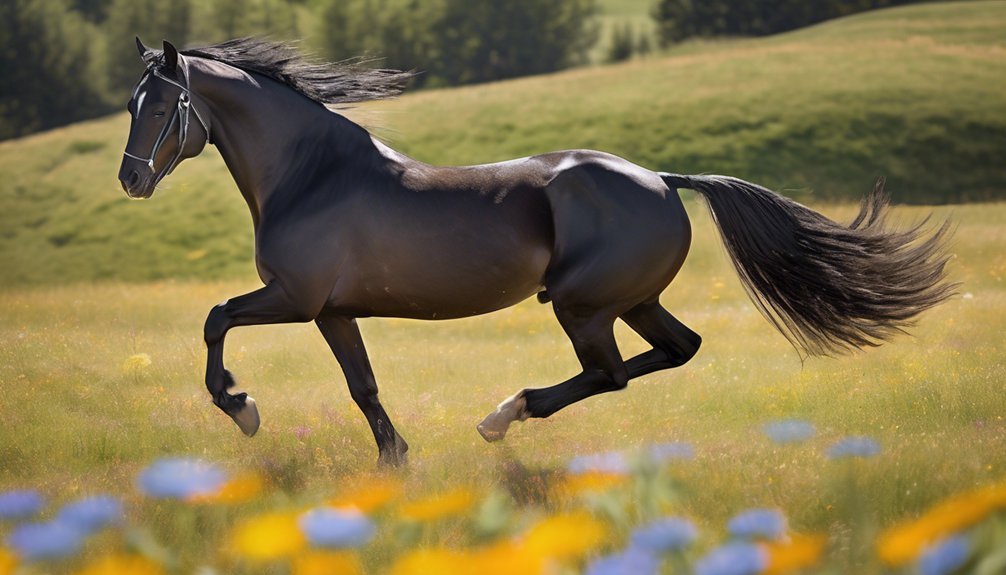
Interval training is an effective method for building stamina in your gaited horse, allowing them to perform at their best during competitions.
Start by incorporating interval sessions into your routine, alternating between high-intensity bursts and periods of rest. For example, you might've your horse trot or canter for two minutes, followed by a five-minute walk.
This strategy challenges their cardiovascular system, promoting stamina building while enhancing recovery times. Gradually increase the duration and intensity of the high-intensity segments as your horse adapts.
Consistency is key, so aim for two to three interval sessions per week. With dedication, you'll notice improved endurance, making your horse more competitive and confident in the ring.
Encouraging Mental Engagement and Focus
As you prepare your gaited horse for competition, fostering mental engagement and focus is crucial for optimal performance.
Start by incorporating activities that provide mental stimulation, such as obstacle courses or varied trail rides. Changing up routines keeps your horse interested and sharp.
Use positive reinforcement to reward your horse when it shows focus and enthusiasm during training. This could be treats, praise, or a break to explore.
Always be aware of your horse's mood; if they seem distracted or disengaged, adjust your training session to reignite their interest.
Engaging your horse mentally not only enhances their performance but also strengthens the bond between you, creating a positive atmosphere that both of you can thrive in.
Monitoring Progress and Adjusting Training
While you train your gaited horse for competition, consistently monitoring their progress is essential for effective training adjustments. Use a structured approach to track improvements, identify areas needing attention, and adapt your methods.
| Progress Tracking | Training Adjustments |
|---|---|
| Record strides per minute | Increase speed intervals |
| Note energy levels post-workout | Adjust feed and rest periods |
| Evaluate responsiveness to cues | Modify training techniques |
| Assess gait quality | Focus on specific gait refinement |
Regularly review your notes and make informed decisions. This proactive strategy will help you create a tailored training plan that supports both you and your horse, fostering a sense of belonging in your equestrian community as you both strive for success.
Preparing for Competition Day
When preparing for competition day, it's crucial to establish a detailed plan that ensures both you and your gaited horse are ready to perform your best.
Effective competition preparation includes not only physical readiness but also mental focus. Here are key steps to follow:
- Groom your horse thoroughly to showcase their best appearance.
- Ensure your tack is clean and properly fitted for comfort and safety.
- Organize your competition essentials, like entry forms and schedules.
- Plan a warm-up routine to get your horse relaxed and responsive.
- Visualize your performance, reinforcing your connection and confidence.
Frequently Asked Questions
What Types of Equipment Are Best for Gaited Horse Conditioning?
For effective gaited horse conditioning, ensure your saddle fits properly to prevent discomfort. Utilize conditioning accessories like weighted boots and lunging equipment to enhance muscle strength and improve overall performance during training sessions.
How Can I Assess My Horse's Fitness Level?
To assess your horse's fitness level, check for fitness indicators like heart rate and muscle tone. Compare these against conditioning benchmarks to see if your horse's ready for the next big adventure or just a leisurely stroll.
Are There Specific Warm-Up Routines for Gaited Horses?
For gaited horse warm-ups, start with 10-15 minutes of walking, gradually increasing speed and incorporating lateral movements. This prepares your horse's muscles and joints, ensuring a safe and effective workout while enhancing performance and flexibility.
What Are Common Injuries in Gaited Horses During Training?
Common injuries in gaited horses include tendon strains and joint issues. Regular lameness evaluations can help identify problems early, while injury prevention strategies, like proper warm-ups and conditioning, ensure your horse stays healthy and competitive.
How Do I Choose a Suitable Trainer for My Gaited Horse?
When choosing a trainer for your gaited horse, check their qualifications and experience with gaited breeds. Consider their training philosophies—do they align with your goals? A good fit fosters trust and enhances your horse's performance.
Conclusion
In conclusion, conditioning your gaited horse for competition is essential for optimal performance. Did you know that horses with a balanced training program can improve their endurance by up to 30%? By focusing on core strength, incorporating varied workouts, and ensuring mental engagement, you'll set your horse up for success. Remember, consistency and attention to detail are key. With the right approach, you'll not only enhance your horse's abilities but also strengthen your bond, making your competition experience even more rewarding.



